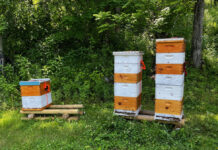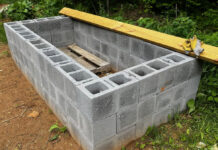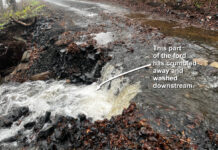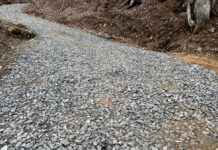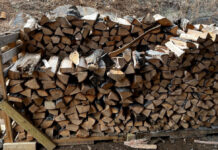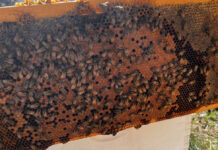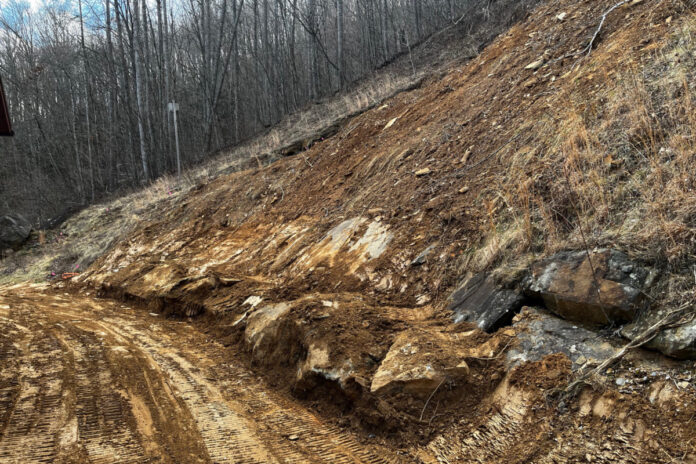
The same contractor we are using to repair our road spent two days cleaning up what is left of our front yard, scooping up truckload after truckload of dirt. Much of the dirt was used as fill to raise the roadbed and ditches back to their prior level.
The giant boulder that slid down the hill in the landslide was split into four pieces so it could be moved. While neither his excavator nor his skid steer could lift some pieces, they could shove the pieces around and he tipped them up to line the hill. Our hope is this will form a platform of sorts that will catch, or at least delay, the small amounts of mud that continue to trickle down.
The contractor also dug up our French drain, which we installed last year. It looked good, so he recovered it. He also uncovered the three surface drains. They had as much as eight or 12 inches of mud on top of them, but it was so thick none of the mud went inside and clogged the pipes. The good news is the investment we made last year in grading and managing runoff was not destroyed.
Replanting the Yard
Before Helene, the yard was grass and clover. Today, it is mud. When things warm up, we’ll truck in a layer of topsoil and replant the grass. I am no fan of lawn-quality grass and don’t want to maintain it, but my wife likes it. I’ll mow it and leave the watering and feeding to her.
The hill where the landslide took place had grass, bushes, flowering shrubs, wildflowers, blackberry brambles, a pine tree, and small black locust trees across it. Today, it is an open wound of mud with erosion obvious. We will be scattering native seeds on the hill. Then we’ll wait and see what grows. Only after these have taken root—along with some goldenrod, no doubt—and the hill stabilizes, will we consider planting larger, more expensive plants. We’ve been told it can take a few years for landslide areas to firm up and become stable. Until then, we could have mini slides.
There are several boulders up the hill which may one day let loose and tumble down. That day may come this spring or in 25 years, if ever. We don’t know.
Before the landslide, I used to look at the giant rocks on the hill and say, “Well, they’ve been there for years and haven’t fallen down yet.” Now I can say, “Well, if they didn’t come down in Helene, I guess they’re stuck there for good.” We don’t know if theses boulders are like icebergs and we can see only 10 percent, with the other 90 well underground, or if they are 49 percent uncovered and if a few more percent of the dirt is washed away, they’ll just slide down the mountain.
Firewood Stacks
Our long double-row stacks of firewood helped protect the house from the landslide by stopping the rocks and dirt. In the process, a cord or more of firewood was buried. I salvaged what I could, maybe two-thirds of it, but the rest was mudded into place. During the cleanup, I salvaged more as the contractor uncovered it. I loaded it into a wheelbarrow, rolled it down the hill, laid it out and sprayed all the mud and dirt off with a hose. Then I stacked it to dry. A tedious process, but not as much work as cutting and splitting new firewood. By the time we burn these particular logs, I’ll be able to say they have warmed me four or five times.
Blocking Future Landslides
I stack all our firewood on pallets, which keeps it off the ground. This helps keep the wood dry and minimizes rotting. The combination of the landslide, being immersed in mud for four months, and the digging with heavy equipment destroyed four of the firewood pallets, leaving large, muddy splinters that ended up on the burn pile. But these pallets were all several years old, so it was no great loss. I already laid down new ones.
Of the eight pallets I have picked up for free, I have already used five. I’ll be getting more to use in combination with the firewood to build my landslide prevention wall.
I took advantage of the weather and the good road conditions to have our second load of firewood delivered. There is room to store four more deliveries, plus the two cords I am cutting and splitting myself. Then we should be set for next winter.
Having our firewood stacked and drying a year ahead of time paid off big this fall as the road was so bad post-Helene a delivery would never have gotten up it. Now that the road is partially repaired, I plan to catch up over the next two months. That will not only ensure us up ample firewood for next winter but the stacks of firewood will once again be there to stop any future landslides.
Gutter Repairs
Three of our gutter downspouts were damaged during Helene. One was knocked off the gutter and wall when the landslide took out the support beam for the carport. Another was badly dented when a tree carried by the landslide hit it. A third was knocked out of kilter, but wasn’t severely damaged. I repaired the first and third and will get to the second one during the next spot of decent weather.
I had never dealt with gutters or downspouts before, but how hard could it be? Well, I made a mistake repairing the first one, but I will learn from that and not repeat the mistake on the second one. My error was trying to salvage the un-bent part of the downspout. I cut off the mangled part and then fitted a new section of downspout onto it. It worked, but it wasn’t fast, easy, or pretty. I would have been better off to replace the entire downspout rather than doing joinery.
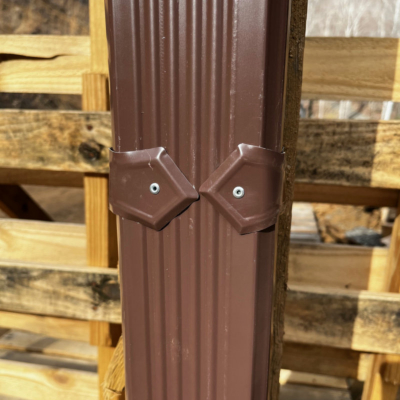
I used rivets to attach the components together, to attach the hangers to the downspout band, which is what the piece of aluminum that attaches your gutter to the building is called. After trying aluminum rivets, I was dissatisfied with their holding power, so I switched to steel rivets. Is using steel rivets on an aluminum gutter was a wise choice? I guess I’ll see how well they hold during the next few storms with high winds and plenty of rain.
I can’t remember the last time I used a rivet, but it was at least 15 years ago. But I had everything I needed in my workshop cabinet, so it was an easy call. I do little metal work, but being prepared can mean having tools and fasteners, as well as food and water.
After I was done, I wondered, should I have watched a YouTube how-to video first? Maybe, but it all worked out in the end.
One Step Closer
It is now four-and-a-half months since Hurricane Helene hit, and we have taken another big step in returning our home to its pre-Helene condition. We’re not done yet, but the mud removal made a noticeable difference. We may not have grass and greenery, but neither do we have piles of mud I need to climb over to get to the chicken coop. Being level makes the yard look more normal, even if it is muddy. And we have the promise of greenery in four months.
The road also continues to improve, and the contractor dropped eight tons for ballast (large gravel) on the road. That improved road conditions, but within a few days the stone was already settling into the mud. When we buy gravel, we usually get 35 to 70 tons, so this was just a drop in the bucket, but gravel and other stone products are hard to come by because of all the road construction. We were lucky to get it, but it is clear we will need more.
One advantage of doing work a bit at a time is it spreads out the costs rather than having to write a big check. We are still waiting to hear from FEMA, so all the repairs to date have been self-funded.
Both the contractor and I took advantage of some unusually warm weather last week to get our work done, but that’s over now. February is already reverting to the mean, temperature-wise. Part of me is looking forward to some cold, snowy weather, so I have an excuse not to work outside. I could use a few days of rest!

